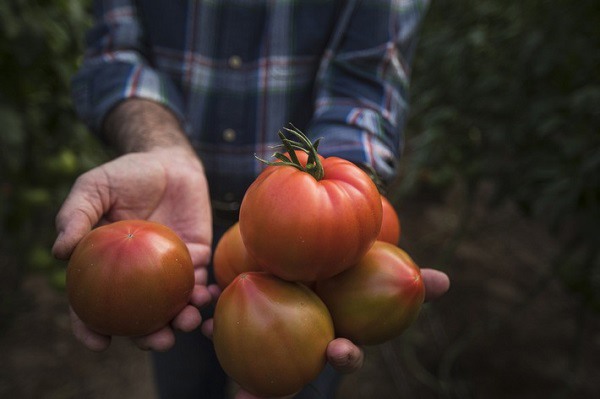The solar greenhouses in southeastern Spain are one of the most important areas for the production of fruits and vegetables for the European market. A total of approximately 4.5 million tons of fruit and vegetables are grown there each year. Of these, around 75% are destined for the European domestic market. The largest importer is Germany: Germany imports around 32% of the products grown in southern Spain. Other major buyers include France (16%), the United Kingdom (12%), and the Netherlands (11%). This makes Spain one of the main suppliers of fruits and vegetables within the European Union.

Tomatoes from solar greenhouses in southern Spain. Photo: Curro Vallejo/CuteSolar
The Germans and their vegetables – just under half of all Germans eat vegetables and salad at least once a week, about 43 % even eat at least one portion a day. The situation is similar for fruit. Around half of Germans eat at least one portion of fruit a day. This means that nationwide consumption is currently around 6.1 million tons of fruit (approx. 73.6 kg per capita) and 8.04 million tons of vegetables (approx. 96.9 kg per capita) per year. In addition to the healthy effects of regular consumption of fruit and vegetables, sustainable cultivation methods are among the most important purchase incentives for German consumers. Sustainable cultivation methods play a central role in the solar greenhouses in southern Spain: The innovative solar greenhouses in the sunny region make it possible to convert the abundant sunlight into healthy and nutritious energy in the form of tasty fresh fruit and vegetables. In this way, sunlight enables local farmers to avoid the use of fossil fuels.
The CuteSolar campaign, supported by the European Union, promotes sustainable fruit and vegetable growing in European solar greenhouses – ensuring the best quality and excellent taste. In the growing areas in the southern Spanish coastal region, mainly tomatoes, peppers, cucumbers, eggplants, zucchini, watermelons, and melons are cultivated. Products that are popular in German kitchens as well. In 2018/2019, for example, Germans consumed 2.25 million tons of tomatoes and 552,000 tons of cucumbers. The sustainably grown fruits and vegetables from southern Spain's solar greenhouses regularly fill our shelves. As the main supplier, Spain thus ensures that consumers throughout Europe can enjoy a diverse range of fruits and vegetables regardless of the season. This means that plates can always be filled with healthy and crisp-fresh fruit and vegetables, especially for Germany, the largest customer.
"Germany is considered the largest buyer of fruit and vegetables from Spain in the European Union. With the help of the CuteSolar campaign, the awareness of fruits and vegetables as healthy and indispensable food should be raised, because fruits and vegetables from southern Spanish solar greenhouses not only convince with quality and taste but are also highly appreciated by consumers because of their particularly sustainable cultivation methods," Juan Carlos Pérez Mesa, Director of the Coexphal-University of Almería (UAL) Chair.
What is a solar greenhouse?
A solar greenhouse is a closed structure covered with a plastic film through which the sun's rays shine, giving the plants the light they need to maintain the right temperature for their development during the winter months, so they can carry out photosynthesis. In the process, plants produce nutrients from the CO2 they absorb from the air and release enormous amounts of oxygen into the atmosphere. Solar greenhouses are very different from the production methods of other greenhouses, which use fossil fuel-based heating and lighting systems that consume up to 30% more energy and are therefore harmful to the environment.
For more information: cutesolar.de
